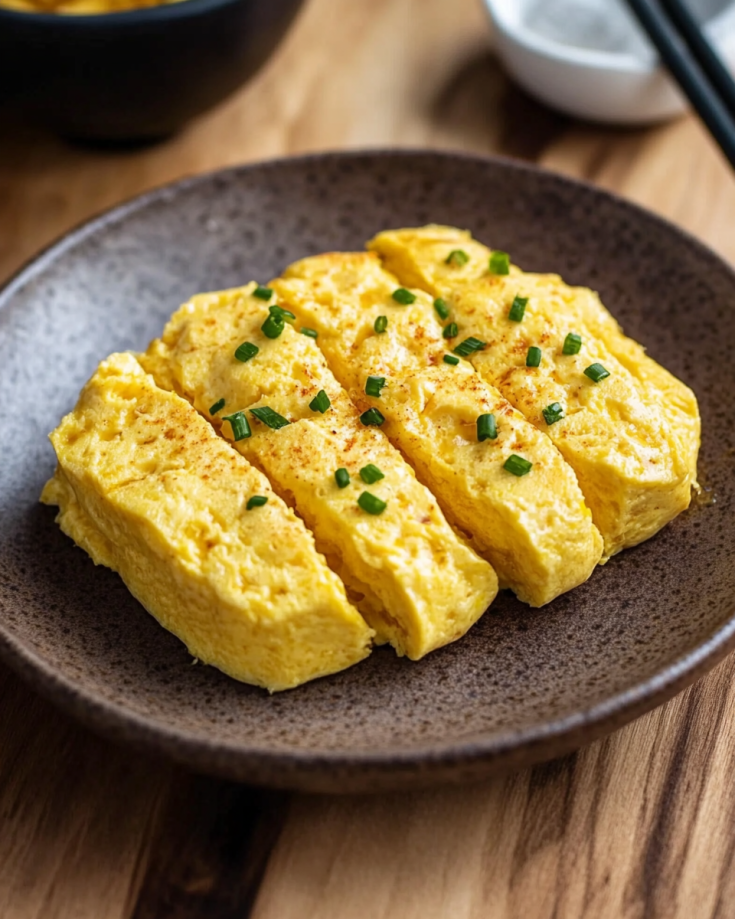The Japanese Tamago Egg, also known as Tamagoyaki, is a beautifully layered rolled omelet that brings together sweetness, umami, and savory richness in every bite. Traditionally served in sushi bars or as part of a Japanese breakfast, this delicate dish is a favorite for both its flavor and aesthetic appeal.
Despite its intricate appearance, tamago is easy to master with a little practice and the right technique. With ingredients like dashi, mirin, soy sauce, and sugar, the eggs take on a complex flavor profile that’s subtly sweet with a touch of saltiness. This elegant dish is as satisfying to look at as it is to eat—perfect for impressing guests or elevating your everyday meal.
Full Recipe:
-
4 large eggs
-
2 tablespoons dashi stock
-
1 tablespoon white sugar
-
1 tablespoon mirin (Japanese sweet rice wine)
-
1 teaspoon soy sauce
-
1 tablespoon vegetable oil (for cooking)
Directions:
-
In a medium bowl, crack and beat the eggs thoroughly.
-
Add the dashi stock, sugar, mirin, and soy sauce. Whisk until well combined.
-
Heat a tamago pan or small nonstick skillet (preferably 5×7 inches) over medium heat. Lightly oil the surface with a brush or paper towel.
-
Pour a thin layer of the egg mixture into the pan. Swirl to coat the bottom evenly. Let cook until the bottom is just set but still soft on top.
-
Using chopsticks or a spatula, roll the egg from one side of the pan to the other.
-
Push the rolled omelet to one side of the pan. Lightly oil the exposed surface again.
-
Add another thin layer of egg mixture, lifting the roll slightly so the new egg mixture seeps underneath.
-
Once the new layer is almost set, roll the existing roll over it, incorporating the new layer into the omelet.
-
Repeat the process until all the egg mixture is used, creating a layered rolled omelet.
-
Remove the roll from the pan and let cool for a minute. Slice into 6 equal pieces to serve.
Prep Time: 5 minutes | Cooking Time: 10 minutes | Total Time: 15 minutes
Kcal: 120 kcal | Servings: 6 servings
What Is Japanese Tamago (Tamagoyaki)?
Japanese Tamago, also known as Tamagoyaki, is a delicate and slightly sweet rolled omelet that holds a cherished place in Japanese cuisine. The name Tamagoyaki literally means “grilled egg” in Japanese, and it is a staple in bento boxes, sushi assortments, and traditional Japanese breakfasts. Unlike Western-style omelets, Tamagoyaki is characterized by its many thin layers of egg cooked in a rectangular or square pan, rolled into a neat log, and sliced into bite-sized rectangles. It’s an ideal combination of beauty, simplicity, and rich flavor.
Tamagoyaki showcases the elegance and restraint often found in Japanese cooking—few ingredients, subtle seasoning, and a refined appearance that can easily be mistaken for a more complicated culinary endeavor. Though it may seem intricate, tamago is actually approachable for home cooks, requiring only a bit of practice to perfect the technique of layering and rolling the eggs. It’s one of those dishes that captures the heart of Japanese cuisine: minimalism paired with maximum flavor and visual appeal.
Cultural Significance and Origins
Tamagoyaki has deep cultural roots and can be found in a wide variety of Japanese meals. Traditionally served in Japanese breakfast sets alongside rice and miso soup, it also appears frequently as part of bento lunches or as a topping for nigiri sushi. In fact, many sushi chefs are judged by the quality of their Tamagoyaki, as it’s considered a test of skill, precision, and flavor balance.
The sweet-and-savory profile of tamago reflects the Japanese palate’s appreciation for subtle contrasts. Its use of mirin and sugar gives it a delicate sweetness, while the soy sauce and dashi add a rich umami undertone. This flavor combination mirrors the traditional Japanese philosophy of food, which often seeks harmony between different tastes.
Historically, Tamagoyaki is thought to have evolved from a technique known as usuyaki tamago, which involved cooking thin crepes of egg to wrap sushi rice or vegetables. Over time, chefs began layering and rolling these thin sheets of egg to form the more modern version we recognize today.
Tamagoyaki in Everyday Japanese Life
Beyond sushi counters and restaurants, Tamagoyaki is a comfort food for many Japanese families. It’s often one of the first dishes children learn to make at home and is a lunchtime favorite in school bento boxes. Its soft, pillowy texture and mild flavor make it widely appealing, even to picky eaters. Parents often cut Tamagoyaki into fun shapes or decorate them to make lunch more visually exciting for children.
In addition to being nutritious, Tamagoyaki holds a nostalgic value for many people in Japan. Recipes are passed down through generations, and each family tends to have its own variation—some preferring it sweeter, others leaning more savory or with the addition of vegetables like grated carrot or scallions.
Technique and Tools
Though it can be made in a round skillet, Tamagoyaki is traditionally prepared using a rectangular or square tamago pan, known as a makiyakinabe or tamagoyaki pan. This special shape allows the egg to be rolled evenly and results in a uniform, square-ended omelet. The pan is often non-stick, which helps prevent tearing during the rolling process.
Mastering the rolling technique is what makes this dish special. Each layer of egg is poured thinly, cooked just until set, and then rolled carefully with either chopsticks or a spatula. Additional layers are then added and rolled into the previous one, building the omelet gradually. This repetitive process is both meditative and rewarding, culminating in a beautiful layered roll.
Timing and temperature control are essential. The heat must be high enough to cook the eggs quickly without overbrowning, but low enough to allow time for rolling without breaking. A small amount of oil is typically spread in the pan between each layer to prevent sticking and ensure smooth rolling.
Flavor Profile and Variations
The hallmark of Tamagoyaki is its sweet-and-savory profile. The eggs are seasoned with dashi (a traditional Japanese stock made from seaweed and dried fish), sugar, mirin (a sweet rice wine), and soy sauce. This combination creates a rich, umami-laced taste that’s delicately sweet, making it an excellent accompaniment to sushi, rice, or eaten alone.
While the classic version is most popular, Tamagoyaki is also incredibly versatile. Some cooks like to add grated yam (yamaimo) to create a softer texture, while others may include finely chopped vegetables or seaweed. There’s also a less sweet, more savory variant called Dashimaki Tamago, which includes a higher ratio of dashi and is often juicier and fluffier.
For a more adventurous take, some chefs even stuff Tamagoyaki with fillings like cheese, eel (unagi), or shrimp, bringing a modern twist to this otherwise traditional dish.
Nutritional Benefits
Tamagoyaki is not only delicious—it’s also nutritious. Eggs provide a good source of protein, essential amino acids, and vitamins like B12, D, and A. The inclusion of dashi introduces minerals like iodine, and when cooked with care, the oil used can be kept minimal, making it a healthy choice for most diets.
Because it’s light, high in protein, and portion-controlled, Tamagoyaki is suitable for those seeking balanced meals. It’s also low in carbohydrates and can be adapted for gluten-free diets by using tamari or gluten-free soy sauce.
Pairing Suggestions
Tamagoyaki pairs wonderfully with a variety of other Japanese dishes. It can be served alongside steamed rice, miso soup, grilled fish, and pickles for a traditional breakfast spread. As part of a sushi meal, it offers a sweet contrast to salty fish and vinegared rice.
It’s also a standout addition to bento boxes, where it complements rice balls, cooked vegetables, and fried chicken. For those hosting brunch or fusion-style dinners, Tamagoyaki can be served with a fresh salad, soba noodles, or even avocado toast for a creative East-meets-West twist.
Tips for First-Time Tamagoyaki Makers
If it’s your first time making Tamagoyaki, here are a few helpful tips:
-
Practice the roll: Don’t worry if your first roll isn’t perfect. The technique improves quickly with repetition.
-
Use a tamago pan if possible: It’s easier to roll evenly and get those beautiful straight edges.
-
Control the heat: Medium-low is often best to avoid browning and to give you time to roll properly.
-
Whisk thoroughly: A well-mixed egg ensures even color and texture throughout.
-
Rest before slicing: Let the omelet rest for a minute or two before slicing to allow the layers to firm up slightly and give cleaner cuts.
Conclusion
Japanese Tamago Egg, or Tamagoyaki, is a beautifully crafted dish that combines art, tradition, and delicious flavor. Its sweet and savory layers, gentle texture, and stunning presentation make it a beloved component of Japanese meals—from breakfast spreads and sushi platters to lunch boxes and elegant dinners.
Whether you’re a fan of Japanese cuisine or simply looking to try something new in your kitchen, tamagoyaki is a must-try. With minimal ingredients and a bit of patience, this humble rolled omelet becomes a culinary masterpiece that’s sure to impress. And as with all great traditional dishes, mastering Tamagoyaki is about more than just technique—it’s about appreciating the cultural heritage and philosophy behind every bite.
Let your tamagoyaki journey begin with an open heart and a steady hand—before long, it may become your favorite go-to egg dish.






